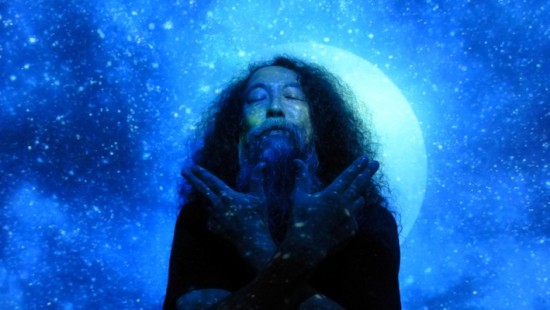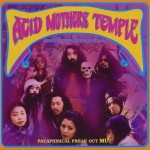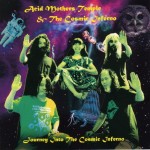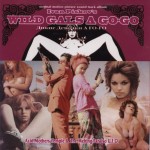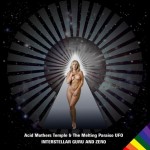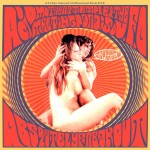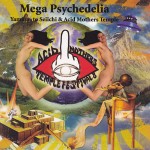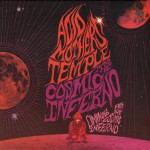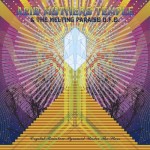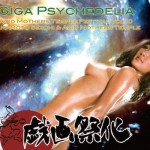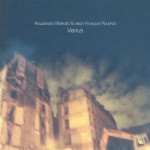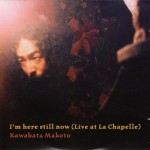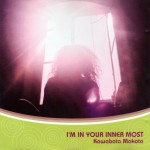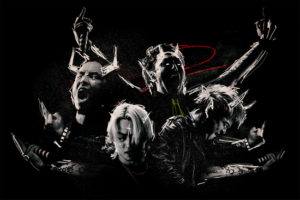Psychedelia & Cosmic Sounds – an interview with Acid Mothers Temple’s Makoto Kawabata (2015.11)
Makoto Kawabata and French guitarist Jean-François Pauvros played a duo show in Budapest on 2015.11.14 and we did an email interview with Mr. Kawabata a week or so before the gig. He is mostly known as the leader and guitarist of Acid Mothers Temple, the psychedelic freak-out group that originally started, as what he calls a ” soul collective” back in the ’90s and by now mutated into a massive, ever changing roster of musicians, involved in countless projects. It actually all began with Acid Mothers Temple & The Melting Paraiso U.F.O which Kawabata started in ’95 more-or-less as a solo outfit with friends from the collective helping out. However it soon turned into an actual band, some new people with similar interest joined and it spiraled out of control from that point. By now, Acid Mothers Temple alone has several mutations, with different line-ups and more or less all the members are involved in countless solo and side-projects as well. One of these is Kawabata’s own solo work, with an incredible amount of releases containing improvised material, that he plays as a self described cosmic receiver, that tries to transmit the sounds it picks up from his inner cosmos.
With their unique music, that mixes psychedelic and prog-rock elements with (amongst others) a bit of an influence from European traditional music, AMT is one of the most prominent examples of Japanese bands that took their cue from Western music, mixed it up and came up with something truly original… that in return impressed mostly Western listeners.
Psychedelic, progressive and experimental rock was introduced to Japan back in the ’70s by bands like Far East Family Band and Flower Travellin Band. Did you listen to these bands back then or you was more influenced by Western music?
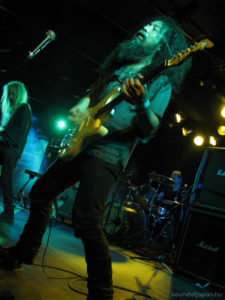
Makoto Kawabata: That is a total misunderstanding. These western music genres were introduced by some underground music magazines, not these musicians. These magazines wrote about psychedelic, prog rock, contemporary music, free jazz, avant-garde, and also post punk and industrial music when these things were happening in the West. And especially about prog rock, Japanese major record companies were distributing so many titles, not even just UK prog, but even French, German (including krautrock), Italian, South American, etc. I didn’t listen to 60’s -70’s Japanese rock at that time, because I felt they were just bad copies of western music. So I preferred only western music that we called “Yogaku (洋楽)”. (While Japanese rock is called “Hogaku (邦楽)”). So I have totally no influence from these Japanese rock bands. I started to find good Japanese rock from the 80’s, for example Ruins, early Boredoms, Noizunzuri, Friction, INU (which later changed into FUNA and Jinmin Olympic Show), Aunt Sally, Non Band, P-Model, Fushitsusha, Katsurei, Hedik (Headache), Sekisei, Animal-Z (ex.Ultra Bide), etc…
Your music has its roots in the ’60s and ’70s, but do you listen to more ‘modern’ music? Is there anything that you find interesting and inspiring nowadays?
Makoto Kawabata: I only like and listen to music that I’m interested in and that I consider good, I don’t care about “new” or “old”. I like so-called “classic rock” these days, rock music from the 60’s to early 80’s (incl. early post punk). Because back in those times rock music acts didn’t have “style” yet, so musicians tried to compose and play better and more differently. But from mid 80’s, rock music was dead for me, after then rock music was too concerned about styles and it was like bands were playing self-covers all the time. After the mid 80’s, I’m not interested in any “rock” and “popular” music. I was always interested and listening to more experimental things than rock since my teens. My first music in my life was Stockhausen from radio when I was 10 or 11 years old (before I discovered rock music). Also I’m really interested in ethnic music ever since my teens too.
You are touring around the World all the time as a solo artist, as a member of AMT or with your other projects and you built up a strong audience both here in Europe and in the US. But how about home? Could you tell us about the scene and audience in Japan? Is it any different from the rest of the World?
Makoto Kawabata: AMT haven’t played in Japan so much since we started to play live in 1997. For example, our first show was not in Japan, it was in San Francisco US. So, for a long time Japanese people didn’t know about us, even when we became a well known band outside Japan. Also I don’t have contact with Japanese music scene since the early 80’s when I started to play live in the Osaka area. I always preferred D.I.Y., I don’t like to be a part of something, I prefer to be really independent from anything. But recently, the last 7-8 years, Japanese people finally discovered AMT, and especially many young people found us. Also when we played in Japan in the early days, we always got many foreigners in the audience, more than Japanese actually. Usually the Japanese audience is shy and silent especially about “underground music” in Japan. But these western people always enjoyed our music with dance and scream and then they were a big influence to the Japanese… It was a really funny thing too and I think it was good for the Japanese people. Because Japanese audience is really different from all other countries’ people. Western audience enjoy the music, Japanese audience listen the music with criticism even their favorite bands. That’s why Japanese audience come to the venue right at the door open time and try to see all support bands too. I think we need both type of audience to keep up a good mindset to play live. Anyway I’m really happy that people enjoy our music.
Why do you think Japanese people seem to have an exceptional capability to absorb, transform and re-channel information? Like listening to a lot of different music, then twist it around and create something completely new and unexpected based on the experiences.
Makoto Kawabata: When we listen to many kind of music, rock, jazz, classical, contemporary, ethnic, easy listening, etc… we don’t think about any historical background and also don’t mind about the lyrics (as English is not our native language). All music were imported to Japan at the same time (around the late 60’s – mid 70’s), so we could listen everything at the same time without much information, which meant that we could listen to them as just “music”. That’s why it was not difficult to mixture everything.
You are known for being involved in countless bands and side-projects and even AMT has several incarnations with different line-ups. Could you round up for us what projects are you involved in nowadays?
Makoto Kawabata: There are some AMT projects with different concepts and line-ups under the big umbrella of Acid Mothers Temple. What’s next? I don’t know… It is always my cosmos that teaches me what I should do.
In an earlier interview you said that you completely ignore the Japanese music media. What is the reason behind this decision?
Makoto Kawabata: They betrayed me all the time. They edited my words like we were some “gossip band”, because their readers would be more interested in their magazines this way. They don’t respect musicians. I heard about musicians that paid magazines to do interview with them and to write disc & live reviews… it’s totally pointless. Who can trust these reviews? I have answered only one interview in Japan during the last 20 years, because I knew that interviewer and that he always respects musicians. Sometime some writers in Japan asked me to get free discs and free tickets of our shows, but always answered NO! I told them “If you want it, you should buy our discs and tickets yourself! Then you can write whatever you want about it, even a bad review as you paid for it. ”
The artwork for your releases are always quite unique: they are like a visual orgy of psychedelia, cosmic elements, archive photos, naked women and of course the band members that often look more like a secret sect of druids than musicians. It is all a bit like a strange twist on afro-futurism, but with a Japanese touch instead of the African elements. What is the concept behind the artworks and who is creating them?
Makoto Kawabata: Nothing!! I’m a kind of so-called “vinyl junky”, I really love to find and buy vinyls at stores. (And not really on the internet, I really like going to stores and coming across records by myself.) And I bought many unknown records just because they had such great artwork. When I make the artwork concepts, I always think about just one thing: how to get people (who has never known anything about AMT) to pick up our records. For me the artwork is just an eye catcher. I can’t compromise anything about music, but I can compromise about artwork to catch people.
In Budapest you will play with the French guitarist, Jean-François Pauvros. The two of you already released a couple of albums together over the years. How did you meet him and started to work together?
Makoto Kawabata: In the late 90’s in Paris, a French producer set up a recording session at the studio with him. He already knew both J.F. and me, but the two of us didn’t know each other yet. So it was the first time to meet J.F. then. The first thing J.F. asked me was “play or talk?” I answered “play”. We set up all pedals, then he took out a bow and I also took out a bow. We were surprised, because we didn’t know that guitarists use bow for guitar at that time, except for Jimmy Page’s funny playing. When we started to play 100% improvised, we felt really similar, as if we were twins. Like we can contact with telepathy. Since then we have played as a duo whenever we could find a chance to do so and we always enjoy it a lot.
Beside him, you also worked with many other musicians including members of such legendary psychedelic and krautrock bands like Can, Guru Guru and Gong. Could you tell us about these collaborations? And is there anyone else who you would like to work with, but haven’t had the chance yet?
Makoto Kawabata: I haven’t asked any of these legendary musicians to play together… because I’m too shy, hahaha. It was always these great musicians that asked me to collaborate. I’ve played with Silver Apples, Träd Gräs Och Stenar, Nik Turner, Charles Hayward and others too… I am so thankful for these chances. So, I have no idea who’s next. My favorite musicians, for example Captain Beefheart, Franck Zappa and others have already passed away. Also I’m really interested in collaborating with young musicians, so if I can find any good musicians, then I propose them. I believe this is my mission as an experienced musician.
acidmothers.com / AMT fb / Makoto Kawabata fb
Disclaimer: this interview was originally arranged for soundofjapan.hu. Big thanks to Cudi Purci Booking for making it possible!

